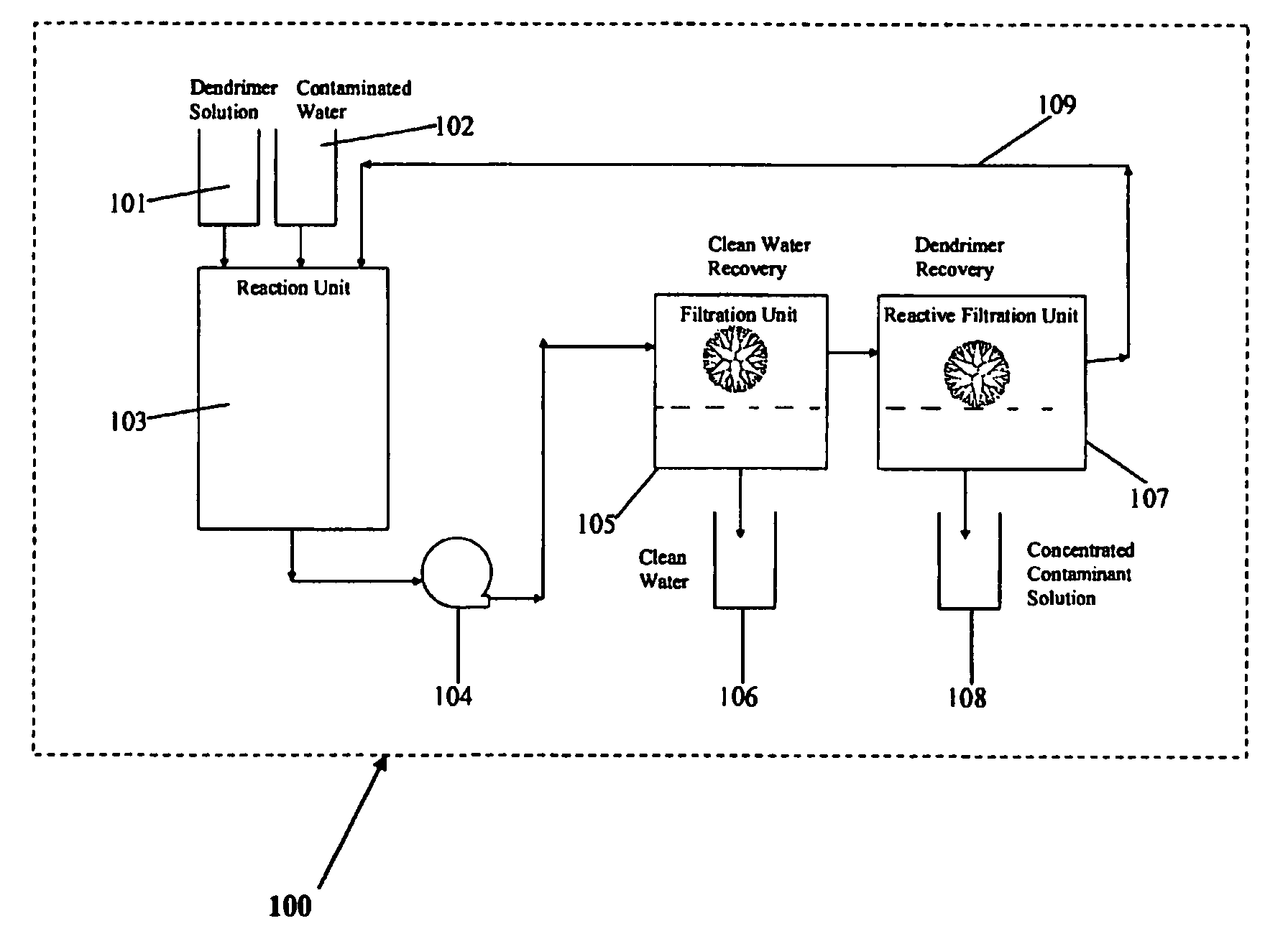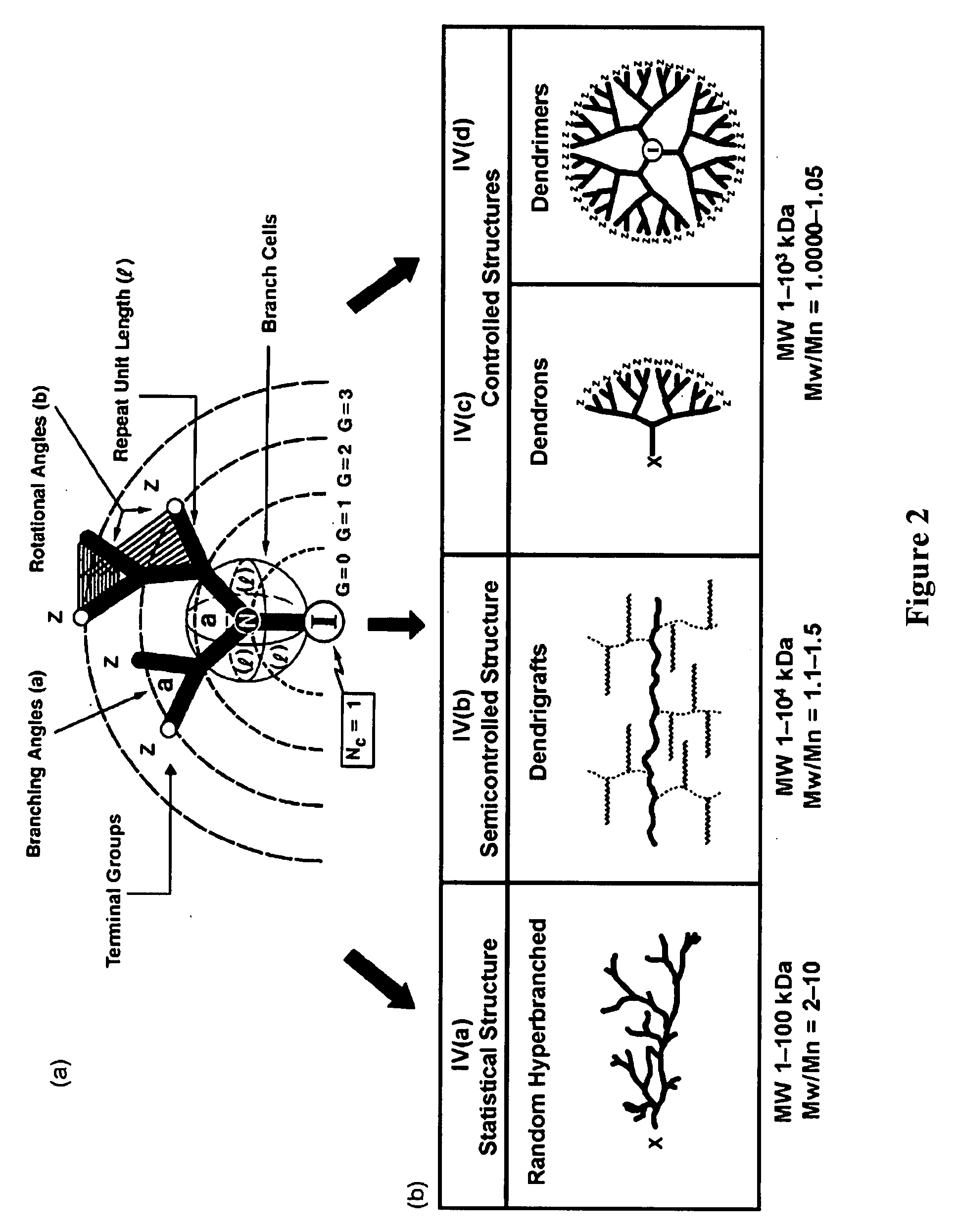Water treatment by dendrimer-enhanced filtration
a dendrimer and filtration technology, applied in the field of dendrimer chemistry, ion exchange, ultrafiltration, water purification, can solve the problems of reducing the level of dissolved species, reducing the efficiency of meuf processes, and correspondingly difficult application of water purification methods under “field conditions”
- Summary
- Abstract
- Description
- Claims
- Application Information
AI Technical Summary
Benefits of technology
Problems solved by technology
Method used
Image
Examples
example 1
Recovery of Cu(II) from Aqueous Solutions Using PAMAM Dendrimers with Ethylene Diamine Core and Terminal NH2 Groups
[0111]PAMAM dendrimers with ethylene diamine (EDA) core and terminal NH2 groups are synthesized via a two-step iterative reaction sequence that produces concentric shells of β-alanine units (commonly referred to as generations) around the central EDA initiator core (FIG. 4). Selected physicochemical properties of these dendrimers are given in Table 5.
TABLE 5Selected Properties of EDA Core Gx-NH2 PAMAMDendrimers Evaluated in this Study.aMwthfRGgRHDendrimer(Dalton)bNNTcNNH2dpKNTepKNH2(nm)(nm)G3-NH2690630326.529.901.651.75G4-NH21421562646.8510.291.972.5G5-NH2288261261287.1610.772.432.72aMwth: Theoretical molecular weight.bNNT: Number of tertiary amine groups.cNNH2: Number of primary amine groups.dpKNT: pKa of dendrimer tertiary amine groups.epKNH2: pKa of dendrimer primary amine groups.fRG: dendrimer radius of gyration.gRH: dendrimer hydrodynamic radius.
[0112]An extensive ...
example 2
Use of PAMAM Dendrimers for Binding to Additional Metals
[0138]By the methods described above, the binding of Co(II), Ag(I), Fe(III), and Ni(II) to PAMAM dendrimers was tested at room temperature as a function of pH and metal ion dendrimer loading. The extent of binding for Co(II) is shown in FIG. 11, for Ag(I) in FIG. 12, for Fe(III) in FIG. 13, and the extent of binding of Ni(II) is shown in FIG. 14.
example 3
Use of Dendrimer Enhanced Filtration (DEF) to Remove Anions
[0139]This example focuses on the use of dendritic ligands to bind perchlorate (ClO4−). The dendrimers used were fifth generation (G5-NH2) poly(propylene) (PPI) dendrimer with a diaminobutane (DAB) core and terminal NH2 groups. This is a water-soluble dendrimer with 64 terminal NH2 groups (pKa=9.8) and 62 internal tertiary amine groups (pKa=6.0) with a theoretical molar mass of mass 7168 Dalton (10).
[0140]The binding assay procedure consisted of (i) mixing and equilibrating aqueous solutions of perchlorate and dendrimer at room temperature, (ii) separating the perchlorate-dendrimer complexes from the aqueous solutions by ultrafiltration and (iii) measuring the concentration of perchlorate in the equilibrated solutions and filtrates. FIG. 15 shows the EOB of perchlorate in aqueous solutions of the G5-NH2 PPI dendrimer as a function of anion-dendrimer loading and solution pH. In these experiments, the molar ratio of anion-dend...
PUM
| Property | Measurement | Unit |
|---|---|---|
| Volume | aaaaa | aaaaa |
| Volume | aaaaa | aaaaa |
| Volume | aaaaa | aaaaa |
Abstract
Description
Claims
Application Information
 Login to View More
Login to View More - R&D
- Intellectual Property
- Life Sciences
- Materials
- Tech Scout
- Unparalleled Data Quality
- Higher Quality Content
- 60% Fewer Hallucinations
Browse by: Latest US Patents, China's latest patents, Technical Efficacy Thesaurus, Application Domain, Technology Topic, Popular Technical Reports.
© 2025 PatSnap. All rights reserved.Legal|Privacy policy|Modern Slavery Act Transparency Statement|Sitemap|About US| Contact US: help@patsnap.com



